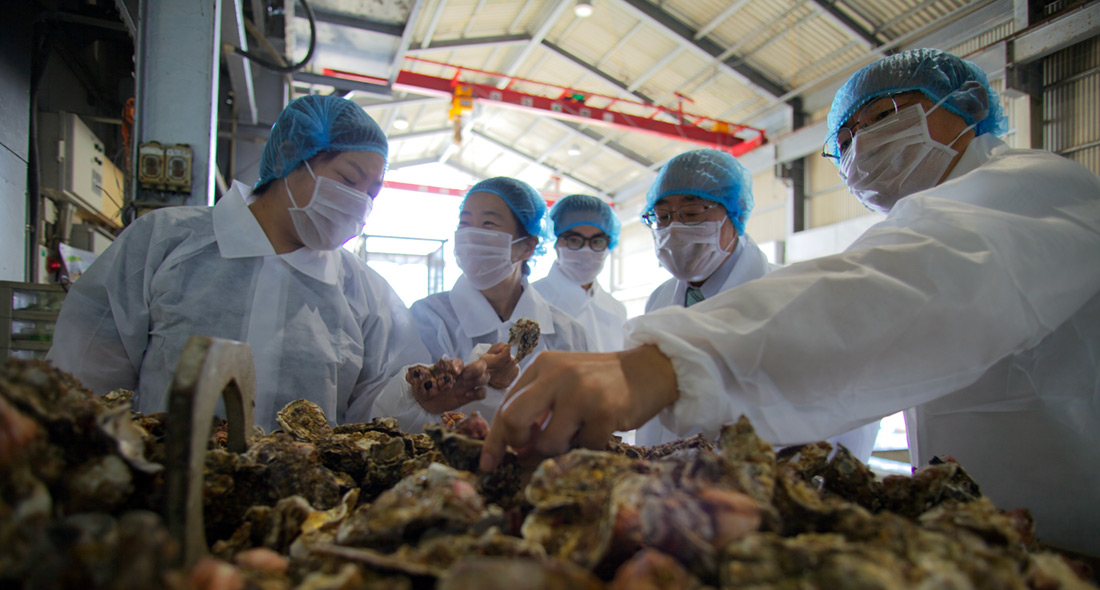Hiroshima Pacific Oyster FIP
A joint project of Ocean Outcomes, Seafood Legacy and UMITO Partners

Overview
This project was initially developed and implemented by Ocean Outcomes and is now managed and maintained by UMITO Partners. View current and any additional project information on the UMITO Partner website.
The unique topography, tidal currents and water temperatures in the marine areas of Hiroshima Prefecture make it an ideal location for oyster farming and fishing. The region accounts for two thirds of Japan’s oyster production, or 20,000 tonnes annually, some of which supplies the Japanese Consumers' Co-operative Union (JCCU), Japan’s largest consumer organization comprised of 29 million members. Since the oyster fisheries’ establishment in 1962, those involved in the oyster fisheries have always focused on quality and safety, but oyster companies now also want to ensure their oysters are produced and seen as eco-friendly.
The Hiroshima Pacific Oyster FIP will work to ensure environmental sustainability of participating FIP companies. Towards this goal, the FIP fishing companies worked with Seafood Legacy and Ocean Outcomes in 2019 to assess their environmental impacts on the marine environment and then developed a workplan to mitigate those impacts going forward. These include monitoring fishery impacts on benthic habitats; decreasing fishery interactions with endangered species, such as loggerhead turtles and the Indo-Pacific finless porpoise; transitioning fishery management to precautionary and science-based strategies; and routine project participant progress meetings.
 Video footage from fishing company Kurahashijima Kaisan shows oyster harvesting methods.
Video footage from fishing company Kurahashijima Kaisan shows oyster harvesting methods.
What We're Doing:
- Convening fishery stakeholders to generate support, participation, and funding, including matching funds and in-kind contributions, for improvement efforts.
- Development and implementation of a fishery improvement work plan to address deficiencies found during the MSC pre-assessment, including plans to better monitor and track interactions with endangered, threatened, and protected (ETP) species, monitor impacts on benthic habitats, and working towards a transition to precautionary and science-based management strategies.
- Supporting the fishery in working towards MSC certification.
Project News and Additional Resources:
- Fishery client Kurahashijima Kaisan Co., Ltd. website
- Pacific Cupped Oyster Enhanced Fisheries in Hiroshima and Hiro Bays MSC Pre-assessment Report
- Japan’s Latest Fishery Improvement Project (FIP) Launches in the Country's Oldest and Largest Oyster-producing Region
- First Oyster Fishery Improvement Project Launches in Japan
Fishery Improvement Project Information:
| FIP Status: | Comprehensive FIP (tracked fully on FisheryProgress.org) |
| Project Launch: | January 2020 |
| Location: | Hiroshima and Hiro Bays, Hiroshima Prefecture, Japan |
| Participants: | Ocean Outcomes, Seafood Legacy, UMITO Partners, Kurahashijima Kaisan Co., Ltd., Japanese Consumers' Co-operative Union (JCCU) |
| Species: | Pacific oyster (Crassostrea gigas) |
| Gear Type: | Rope grown |
| Volume: | 820-860 tonnes - The five companies involved in the FIP produce a combined 820-860 tonnes of Pacific oysters per year. The fishery as a whole produces roughly 20,000 tonnes. |
| Documents: | Pre-assessment / Workplan |